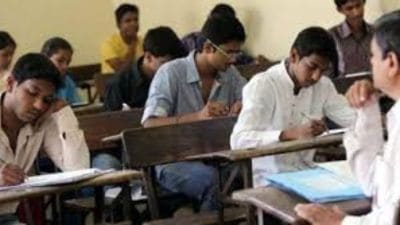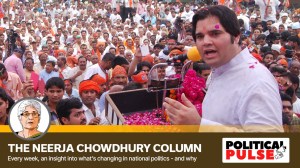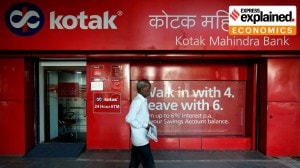- India
- International
Those who crafted gold ornaments are digging ditches today
Lakhs of skilled migrants who returned to West Bengal during the lockdown and Unlock 1 are desperate to go back to the lives and livelihoods they had to leave behind virtually overnight.
 Migrant workers in Sojipur village, Burdwan. (Express photo by Partha Paul)
Migrant workers in Sojipur village, Burdwan. (Express photo by Partha Paul)
Sheikh Aulad Ali, 39, used a spade to scoop mud from the roadside in Sojipur village of Jamalpur block in Burdwan district, and splattered it uncertainly into a basket — which a co-worker, Sheikh Sobur Ali, overturned on the other side of the road.
This isn’t work that Aulad knows or enjoys. Like many in his village, he is an experienced goldsmith, whose artisanship earned him a monthly salary of Rs 19,000 until before the lockdown. He returned from Punjab on a Shramik Special train and spent 14 days in quarantine before getting MNREGA work that earns him Rs 204 daily. Every day, he waits for his boss in Punjab to call him back.
Aulad’s situation is similar to that of lakhs of skilled migrants who returned to West Bengal during the lockdown and Unlock 1. They are desperate to go back to the lives and livelihoods they had to leave behind virtually overnight. Not everyone has got MNREGA work, and it pays far less than what they used to earn. Some of these workers have started to look for jobs in districts other than their own; many have managed to obtain ‘health certificates’ from private doctors, which they hope will help them get work.
Read | 86 per cent jump in MGNREGA demand in districts most migrants returned to
“I create intricate designs on gold. I have done that work for 18 years, and I have been in Punjab for the last third of those years. Today I am digging ditches in my village. My hands are not suited to this work, but I have no option,” said Aulad, who has elderly parents, his wife, and a daughter to support.

Aulad was one of a group of 22 returned migrant workers digging drains on either side of a road in Sojipur village. All of them were freshly out of quarantine. Most were goldsmiths; a few were construction workers. There are 580 families in Sojipur; the men of 80 per cent of those families have been working in another state or elsewhere in Bengal.
Sheikh Khorshed Ali, 22, also a gold worker, returned to Sojipur from Surat. “Our work stopped on March 21 evening, and we survived somehow before making it back by a Shramik Special.
Now my maalik says the gold market will not start before Diwali,” he said. Abed Ali, 32, said it was good to have got something to do in Bengal, “but I have worked in the jewellery field in Surat for 11 years, and will go back at the first opportunity”.
Sahabuddin Mondol, upa-pradhan of the Jamalpur 1 Gram Panchayat, said job cards had been cleared for about half of the 500 fresh applications that were received in the panchayat. “This is a temporary solution,” he said. “Only certain kinds of works are allowed under MNREGA, and there is a huge demand for job cards; we can never give them all work continuously for long.”
According to government estimates, some 10.5 lakh migrant workers have returned to Bengal from other states; officials said over 4 lakh new names have been added to the list of MNREGA beneficiaries.
Subhankar Majumder, BDO, Jamalpur 1, said: “The administration has started the mapping of migrant workers. A survey is ongoing. We are categorising them according to their skills and sectors. The survey also asks them whether they want to stay or go back. Some have said they want to stay. We will provide them with opportunities for skill upgradation and other help.”
Most of those who have returned to Purba Ramchandrapur village under Bhatar police station, about 55 km from Jamalpur, used to work in Mumbai, Surat, or Kerala as embroidery or zari workers, and gold artisans. Almost no one has got a job card; some are too disheartened to even apply.
“I was paid Rs 760 per day in Kerala as a mason at construction sites, apart from khoraki (food). I have not applied for a job card. How much can it pay? I have contacted two of my friends from this village who are still in Kerala. After Qurbani (Bakrid, on July 31) I will go back,” said 40-year-old Danishur Rehman, who is the only earning member of a family of five including two children.
Mollah Hamid said he has a small embroidery workshop in Mumbai, where he has been living for the past 27 years. “After the lockdown, I returned to the village. My daughter studies in Class 10, son in Class 6 in Mumbai. They are now attending classes online. We will leave as soon as the situation (in Mumbai) improves,” he said.
Sheikh Rafiqul, who returned with his wife Hasanara and son Aqib, 4, from Surat, said he had not been paid his salary of Rs 16,000 for three months, but his employer had promised to pay after he went back.
At the 1,100-acre Calcutta Leather Complex (CLC) in Bantolla, South 24-Parganas, which has about 400 tanneries and 100 leather units, a few workers have started to return from Bihar, even though there aren’t many orders yet.
“I am earning at least something here,” said Subodh Shaw of Darbhanga, who ferries raw hide on a motorised van. “I used to make five or six trips a day; now I make only one or two. I get Rs 100 per trip,” he said.
Ganesh Ram from Muzaffarpur stayed on in Kolkata because he could not afford to pay Rs 1,500 for a bus home. “The CLC tanners’ association gave us food. I am now waiting to get back to work.” He got Rs 300 per day before the lockdown, and Rs 40 for every hour of overtime work, Ram said.
“70% of the workforce are migrant labourers from Bihar and UP. Most of those who went back are yet to return. We need labourers urgently. Our units are running at just 25-30 per cent capacity. We will meet soon to discuss whether to send buses to bring them back,” Imran Ahmed Khan, general secretary of the CLC Tanners Association, said.
Apr 24: Latest News
- 01
- 02
- 03
- 04
- 05







































